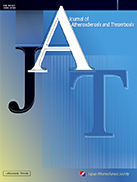All issues

Predecessor
Volume 20, Issue 8
Displaying 1-4 of 4 articles from this issue
- |<
- <
- 1
- >
- >|
Committee Report
-
Executive Summary of the Japan Atherosclerosis Society (JAS) Guidelines for the Diagnosis and Prevention of Atherosclerotic Cardiovascular Diseases in Japan—2012 VersionTamio Teramoto, Jun Sasaki, Shun Ishibashi, Sadatoshi Birou, Hiroyuki ...Article type: Committee Report
2013Volume 20Issue 8 Pages 655-660
Published: 2013
Released on J-STAGE: August 26, 2013
Advance online publication: July 26, 2013JOURNAL OPEN ACCESSDownload PDF (987K)
Original Article
-
Mitsuyoshi Takahara, Naoto Katakami, Hideaki Kaneto, Midori Noguchi, I ...Article type: Original Article
2013Volume 20Issue 8 Pages 661-669
Published: 2013
Released on J-STAGE: August 26, 2013
Advance online publication: April 22, 2013JOURNAL OPEN ACCESSAim: Some employees have difficulty undergoing health checkups in the workplace in a fasting state. However, hypertriglyceridemia is usually diagnosed based on fasting triglyceride (TG) measurements. The current study investigated the performance of non-fasting health checkup data for predicting hypertriglyceridemia in a Japanese population.
Methods: We recruited a total of 1,959 Japanese employees who had their fasting TG levels reexamined after undergoing initial health checkups under either a fasting (the fasting population; n= 856) or non-fasting state (the non-fasting population; n= 1103). Hypertriglyceridemia was defined as a fasting TG level of ≥1.7 mmol/l.
Results: The area under the receiver operating characteristic (ROC) curve of the initial TG measurements for reexamination-detected hypertriglyceridemia was 0.85 in the fasting population and 0.83 in the non-fasting population. The area under the ROC curve of the initial TG measurements in the non-fasting population was not inferior to that of the multivariate model where other non-fasting health checkup data were added. The optimal non-fasting TG cutoff point was 2.0 mmol/l. The cutoff point was further lowered when the population was limited to patients undergoing health checkups four or more hours after their last meal and when the prevalence of hypertriglyceridemia in the population was simulated to be reduced.
Conclusions: The non-fasting workplace TG measurements by themselves exhibited a tolerable performance for predicting hypertriglyceridemia. The optimal cutoff point in Japanese employees appears to be lower than 2.3 mmol/l, the recently proposed Western cutoff point.View full abstractDownload PDF (2654K) -
Ayaka Tsuboi, Mayu Watanabe, Tsutomu Kazumi, Keisuke FukuoArticle type: Original Article
2013Volume 20Issue 8 Pages 670-677
Published: 2013
Released on J-STAGE: August 26, 2013
Advance online publication: April 25, 2013JOURNAL OPEN ACCESSAim: There have been inconsistent reports regarding the relationship between the iron status and coronary vascular diseases (CVD). Recently, low serum iron levels have been shown to be associated with mortality from CVD in women.
Methods: The relationships between the serum iron levels and traditional and nontraditional risk factors for CVD were examined in 202 community-living elderly Japanese women.
Results: The women in the lowest iron tertile had higher high-sensitivity C-reactive protein (hsCRP) and tumor necrosis factor-α (TNF-α) levels than the women in the top iron tertile (p<0.01 or less for both). In addition, the women in the lowest tertile had higher serum levels of adiponectin and copper and ratios of serum copper to zinc and lower serum levels of albumin, hemoglobin and hematocrit. Furthermore, the women in the lowest tertile had higher creatinine levels and lower eGFR values, although there were no significant differences in the prevalence of chronic kidney disease between the three tertile groups. In a multiple regression analysis including the levels of hsCRP, TNF-α, adiponectin and serum creatinine and the ratio of serum copper to zinc as independent variables, the levels of hsCRP, TNF-α and adiponectin emerged as independent determinants of the serum iron level (R2= 0.106). In the model to which the hemoglobin level was added as an independent variable, the levels of hemoglobin, hsCRP and TNF-α emerged as independent determinants of the serum iron level (R2= 0.192).
Conclusions: The present study demonstrated that community-living elderly Japanese women with low serum iron levels have nontraditional risk factors for CVD, including low-grade inflammation and higher levels of serum adiponectin.View full abstractDownload PDF (1393K) -
Michiaki Miyamoto, Kazuhiko Kotani, Kenta Okada, Akihiko Ando, Hideyuk ...Article type: Original Article
2013Volume 20Issue 8 Pages 678-687
Published: 2013
Released on J-STAGE: August 26, 2013
Advance online publication: May 02, 2013JOURNAL OPEN ACCESSAim: The aim of this study was to investigate the relationship between atherosclerotic manifestations and brachial and radial arterial wall elasticity (AWE) measured using the phased tracking method in patients with type 2 diabetes mellitus (T2DM).
Methods: This study included T2DM patients (n= 220, mean age 59 years) without a history of stroke or coronary artery disease. The brachial AWE, radial AWE, carotid mean intima-media thickness (IMT), max-IMT and flow-mediated vasodilation (FMD) were measured. The patients were classified according to the number of atherosclerotic risk factors, including obesity, dyslipidemia and hypertension. Group 1 included T2DM patients only, group 2 included patients with two risk factors, group 3 included patients with three risk factors and group 4 included patients with four risk factors. The patients were also divided into two groups according to microangiopathic complications, including retinopathy and nephropathy. The between-group differences were analyzed.
Results: The brachial AWE (548, 697, 755 and 771 kPa for groups 1, 2, 3 and 4, respectively) and radial AWE (532, 637, 717 and 782 kPa for groups 1, 2, 3 and 4, respectively) significantly increased in association with an increasing number of risk factors. The brachial AWE and radial AWE were significantly higher in the patients with microangiopathic complications than in those without microangiopathic complications (brachial AWE 797 and 694 kPa and radial AWE 780 and 660 kPa, respectively). Receiver operating characteristic curve analyses revealed that, for brachial AWE and radial AWE, the area under the curve was equal to the max-IMT and higher than the mean-IMT and FMD.
Conclusions: Upper limb AWE measurement can reflect the degree of atherosclerosis risk overload and may be useful for evaluating vascular complications in T2DM patients.View full abstractDownload PDF (1070K)
- |<
- <
- 1
- >
- >|